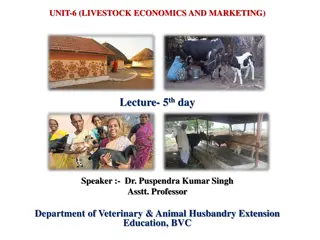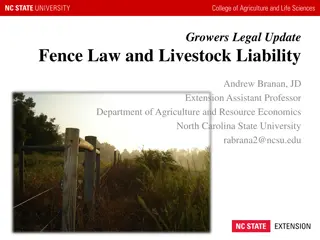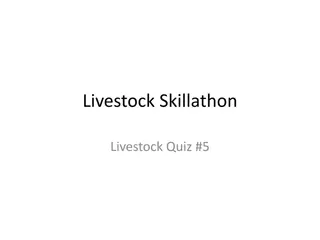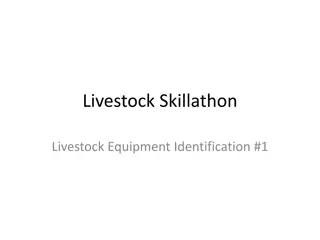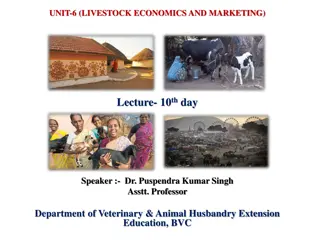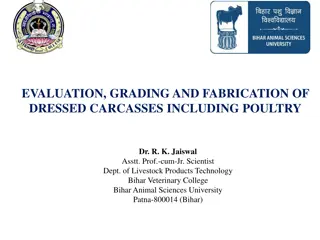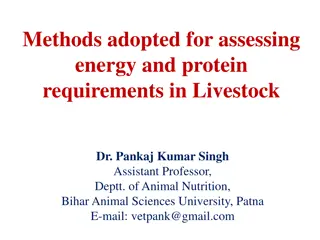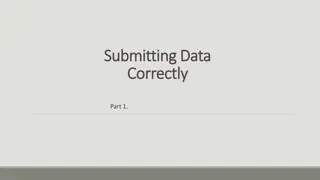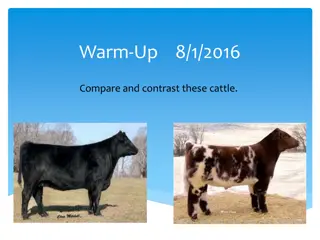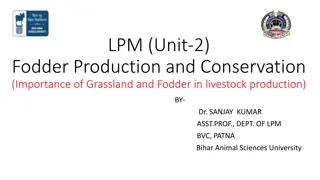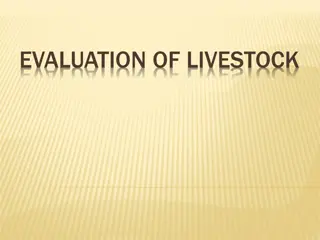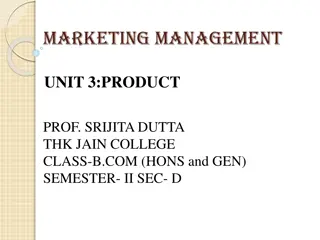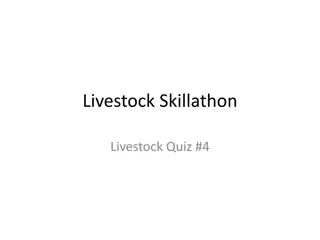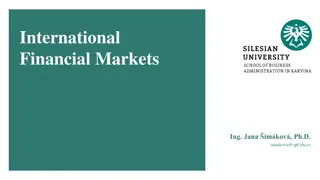Livestock Economics and Marketing: Understanding Markets and Classification
Livestock markets are essential for the buying and selling of livestock and related products. Markets can be classified based on various factors such as location, nature of commodities, time span, and more. Understanding the essentials of markets, livestock market components, and classification helps in better market analysis and decision-making in the livestock industry.
Download Presentation

Please find below an Image/Link to download the presentation.
The content on the website is provided AS IS for your information and personal use only. It may not be sold, licensed, or shared on other websites without obtaining consent from the author. Download presentation by click this link. If you encounter any issues during the download, it is possible that the publisher has removed the file from their server.
E N D
Presentation Transcript
UNIT-6 (LIVESTOCK ECONOMICS AND MARKETING) Lecture- 7thday Speaker :- Dr. Puspendra Kumar Singh Asstt. Professor Department of Veterinary & Animal Husbandry Extension Education, BVC
Topics covered Market, Classification of market.
Market Market derived from Latin word Marcatus It is a place where actual buying and selling takes place. A place where goods and services are exchanged. Meeting together of people for their private purchases and sale of goods at a stated time and place.
Essentials of market 1. Commodity which has to purchase or sale Presence of buyer and sellers for that commodity 2. A place or platform where buying and selling has to be done 3. Such type of interaction between buyer and seller so that the same 4. price prevails for same products at the same time.
Livestock market Livestock market can be classified in to following component: 1. Live animal marketing 2. Livestock product marketing 3. Other products a. Byproduct b. Waste product
Classification of Markets 1. Location 8. Nature of commodities 2. Area or Coverage 9. Stage of marketing 3. Time span 10. Extent of public intervention 4. Volumes of transaction 11. Type of population served 5. Nature of transaction 12. Visibility 6. Number of commodities 7. Degree of competition
A. Location 1. Village markets: These markets cover a village. Transaction take place between buyers and sellers who belong to the village. 2. Primary markets: These markets are located in big towns. The producers bring their produce in these markets and transactions are mainly take place between these and the traders. 3. Secondary wholesale markets: These markets are mostly located in district headquarters, larger towns or near important railway junctions. Producers from far away primary market or other markets come with their produce. Transactions take place in large quantities with wholesalers/traders. 4. Terminal markets: These markets are located mostly in metropolitan cities and sea ports. These markets at Organized, operate under government regulations and have advanced processing and storage infrastructure. 5. Seaboard markets: These are markets specifically meant for trade in international markets. These are located in seaport towns.
B. Area or Coverage 1. Local market : The area covered by this market is limited to some groups of villages. These markets are hence also known as village markets or primary markets. In these markets, mostly perishable commodities are bought and sold. 2. Regional market : The area of operation under a regional market may range from 1-3 districts to even an entire state. Food grain market is the most common example under regional market. 3. National market : Here, the entire country is the area of operation of the market. Common examples are mostly related to durable goods like jute, tea, textiles, etc. 4. International/world market : Here, the area of operation of the market is extended over the entire world. Naturally, this market exists for those commodities which have world-wide demand.
C. Time span Short period market: Held for a day or few hours Highly perishable products Prices of commodities governed mainly by extent of demand Long period market : Comparatively held for a longer period Commodities traded are less perishable Prices are governed both by the supply and demand forces Secular market: Market of permanent nature Trades durable commodities
D. Volumes of transactions Wholesale market: Commodities are bought and sold in large lots Generally located in towns/cities Economic activities are so intense Balancing supply and demand, discovery of the prices Retail market: Commodities bought and Sold to the consumers as per their requirements Transactions take place between retailers and consumers Near to consumers
E. Nature of transactions Spot or Cash market Goods are exchanged for money immediately after the sale Forward market: Purchase and sale of a commodity take place but exchange take place on some specified date in the future Sometime there may not be any exchange, instead differences in the purchase & sale prices are paid or taken
F. Number of commodities General market: All types of commodities are bought and sold Specialized market: Notified commodities are bought an sold
G. Degree of competition Perfect market : Large number of buyers and sellers, All have perfect knowledge of demand, supply and prices Prices are uniform over a geographical area, period of time, different forms of a product Imperfect market: Conditions of perfect competition are lacking Different prices for the same basic product a. Monopoly market b. Monopsony market c. Duopoly market d. Duopsony market e. Oligopoly market f. Oligopsony market
H. Nature of commodities Commodity market Manufactured & semi manufactured goods market Bullion market Service and labour market Capital market : It responsible for meeting the financial requirements of big industrial and commercial concerns MONEY MARKET: Allow those who are in need of money to take loans in turn by way of interest STOCK EXCHANGE MARKET: Shares are purchased and sold to make investments in public and private sector undertakings FOREIGN EXCHANGE MARKET: Buying and selling of foreign currencies concerned with export and import trade
I. Stage of marketing Producer market Mainly assemble the commodity for further distribution Consumer market Collect the produce for final disposal to the consuming population
J. Extent of public intervention Regulated market Business is done in accordance with the rules and regulations framed by the statutory market organization representing different sections involved in markets Marketing cost are standardized and practices are regulated Unregulated market Traders frame the rules for the
K. Type of population served Urban market Rural market
L. Visibility Black market Scarce commodities are sold at a very high price in a secret manner Situation arises on account of excess of demand over limited supply It is an anti social activity which gives way to black money.





